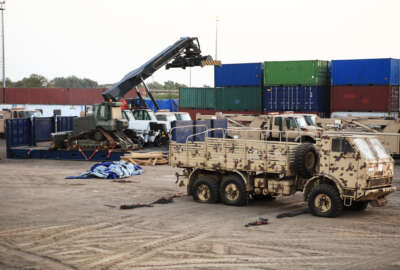How the DLA pivoted to work supply chains during COVID
The Defense Logistics Agency is in charge of moving $40 billion worth of goods around the world per year, but when COVID hit and supply chains started moving in...
The Defense Logistics Agency is in charge of moving $40 billion worth of goods around the world per year, but when COVID hit and supply chains started moving in fits and starts, the organization had to start changing to get goods delivered on time.
DLA works on delivering everything from food to fuel generators to respirators, all important components of the supply chain during COVID.
“When COVID came along, initially, the early efforts were really focused on the operational support,” Rear Adm. Doug Noble, director of logistics operations for DLA, said on Federal Insights: Supply Chain. “From a DLA perspective that quickly evolved to things like personal protective equipment and ventilators. We’ve done over 325 million test kits, over 5 billion sets of gloves, 70 million N-95 masks, almost 300 million surgical masks, and 200 million gowns and just shy of 6,000 ventilators.”
Noble said DLA worked closely with the Federal Emergency Management Agency to find ways to deliver quickly in emergency situations.
“We quickly found ourselves evolving into a role of providing support to FEMA for their mission assignments, but also maturing our relationship with [the Department of] Health and Human Services to provide those items,” Noble said. “As time progressed a little bit further, we were able to get the supply chain to the point where we could start working on restocking the Strategic National Stockpile with all that critical PPE. As a result of working through that process, we have agreements now with HHS where we’ve done about $5 billion to replenish that Strategic National Stockpile.”
Noble said there is still about $7 billion more that needs to be restocked.
As DLA and the nation as a whole builds back its supply chains, Noble said the Defense Department is rethinking its security.
Reliance on China, Russia and other countries, as well as threats from terrorism and extreme weather can all disrupt critical goods from getting to their destinations.
Noble said DLA is working to identify what are the most critical supply chains so they can be protected in the future.
“Can you sift through all that data and that information to know where you really need to prioritize? And to identify those critical items, we engage through the services to pick out those items. They tell us what weapon systems are their critical key weapon systems,” Noble said. “Through the configuration management of those systems we’re able to identify what the key components and the key parts are that would render a weapon system inoperable if the parts weren’t available.”
DLA is also working on the ability to surge a supply chain when needed. Noble said that DLA is partnering with companies to increase supplies even when they aren’t in short supply at the time.
“We have a program that we call our war stopper program, where we address critical needs across multiple supply chains that normally it wouldn’t be economically feasible or supportable to stock all these items because they’re the ‘just-in-case’ items,” he said. “It just would be cost prohibitive to try and maintain all that capability all the time. But through innovative contracting strategies with vendors, we do things like paying a small insurance premium to reserve capacity capability so that we can surge.”
Copyright © 2024 Federal News Network. All rights reserved. This website is not intended for users located within the European Economic Area.
Scott Maucione is a defense reporter for Federal News Network and reports on human capital, workforce and the Defense Department at-large.
Follow @smaucioneWFED







